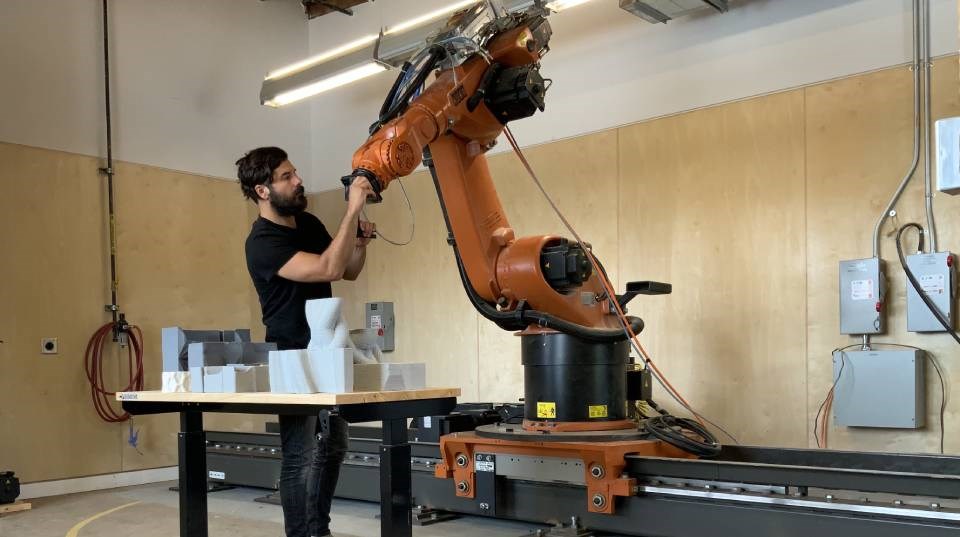For years, 3D printers were inaccessible to the average person – heavy, expensive and complicated to operate. Their use was reserved for those working in industrial applications.
Then in 2009, when patents on the printing process expired, developers adapted the technology to be available to consumers.
Today, for a little more than $300, anyone can purchase a desktop 3D printer and be producing high-quality models, building components, and more, in just a few hours.
That's the kind of equalizing impact Dr. Steven Beites' cable-directed parallel robot (CDPR) could have on Northern Ontario construction practices.
As part of a new research initiative through Laurentian, the two-year endeavour, set to officially get underway in September, taps into the expertise of researchers from multiple disciplines.
Working with Beites are Marc Arsenault, an associate professor from the science, engineering and architecture department at the Bharti School of Engineering; Blake Dotta, a Laurentian sessional instructor with a specialty in behavioural neuroscience; and Reza Foruzanmehr, a civil engineer, who joins the team from the University of Ottawa.
On July 6, the team received $250,000 for the project from the New Frontiers in Research Fund, an initiative of the Canada Research Coordinating Committee.
A CDPR is a computer-controlled robot that uses a system of cables and pulleys to perform a specific function, like building a brick wall, based on a pre-determined blueprint.
Probably the best known example of a CDPR is the National Football League’s SkyCam: suspended above a playing field, it travels where traditional cameras can’t film on-field action during football games.
Beites’ team wants to build a CDPR that could be used to construct large-scale projects – everything from small objects to furniture to structures to housing.
The team believes this automated fabrication and assembly technology could be employed to address the housing issues in remote northern communities where building and labour costs are expensive.
“An interest of mine has always been how do we bring some of these digital fabrication tools to other communities in a way that we can eliminate some of the barriers to entry when it comes to fabrication,” explained Beites, an assistant professor at the McEwen School of Architecture at Laurentian University and a principal at the design and fabrication studio Studio Kimiis in Toronto.
Traditional fabrication equipment like CNC machines, plasma cutters, or laser cutters are all operated by computer-aided design or manufacturing software, which is proprietary and requires a certain level of expertise to use, Beites said.
The robot his team wants to devise would be easy to use, cost-effective, and portable.
“So we are developing a CDPR that would allow a non-professional user to engage with the platform and, as proof of concept, we want to work with communities to demonstrate both the potential of the platform, but also immerse community participants into the design fabrication process,” Beites said.
Want to read more stories about business in the North? Subscribe to our newsletter.
They’re currently evaluating how to design the robot to handle multiple building techniques and materials, including a 3D printer using clay and concrete, a spindle that could work with timber, and a gripper that could pick up and place objects like bricks or blocks.
“So the system itself could work at different levels based on those three manufacturing capabilities,” Beites said.
Alongside the building mechanism, the team is also developing an interface that would make operation of the robot user-friendly.
Beites said it could be anything from a series of air tap-and-drag gestures to a multi-touch screen to a command-driven program using augmented reality goggles.
Development on the robot has been ongoing for about a year, Beites said, and he’s hopeful of reaching the prototyping stage shortly. It’s still too early to determine where the robot could be used first.
But community engagement has always been a high priority for the McEwen School of Architecture, Beites said. Stakeholder consultation will play a large part in determining where and how this technology can be used to benefit communities across the North.
Wherever it ends up, Beites believes the CDPR could act as a “catalyst to a creative economy,” by engaging residents in coming up with their own local building solutions.
Ultimately, he’d like to make the robot available as an open source product, meaning anyone could use the design to build their own, for use on their own projects.
“We feel that by providing non-professional participants with this ability to engage with this technology, it could lead to potentially some socioeconomic development in the region, and I think that becomes really exciting.”




